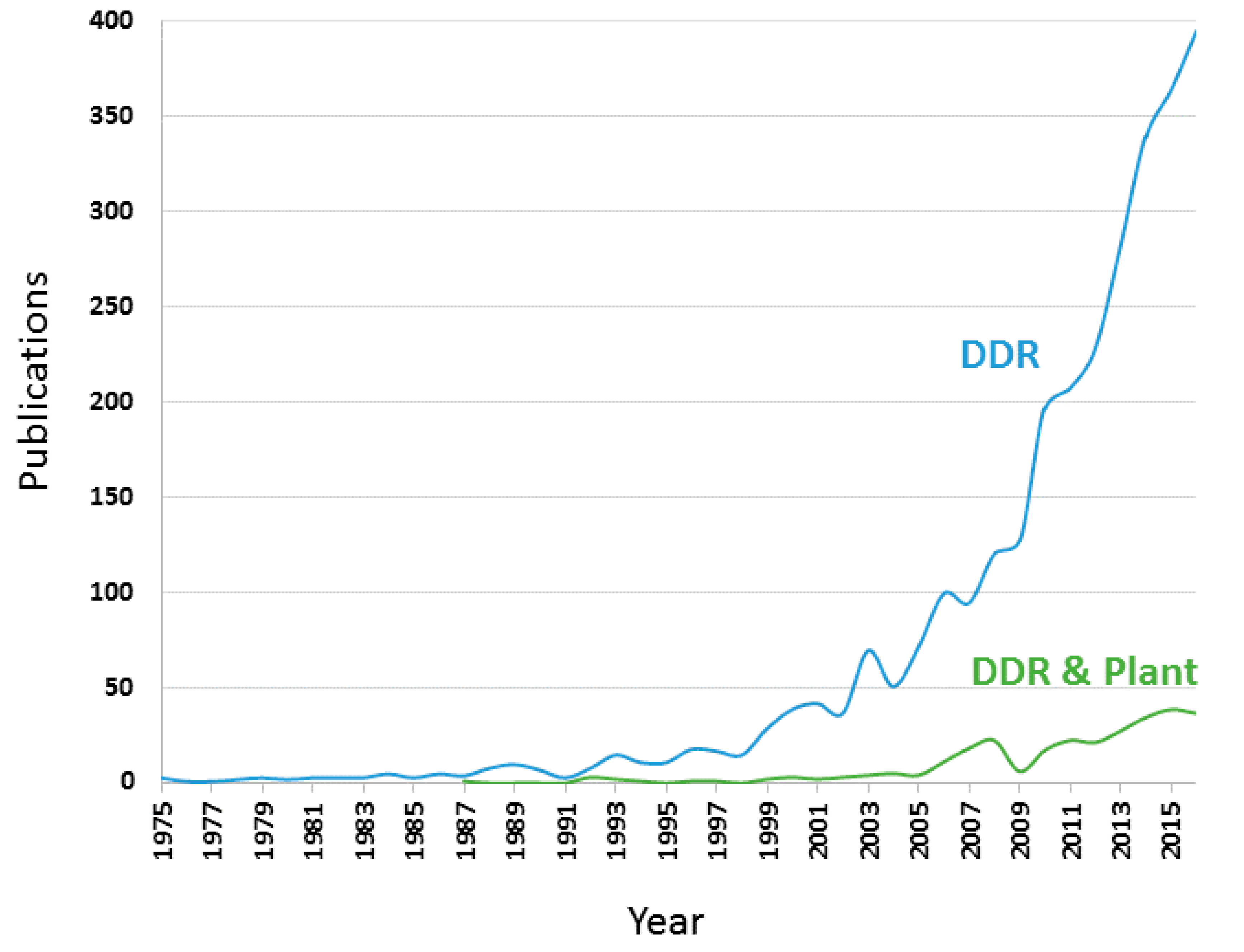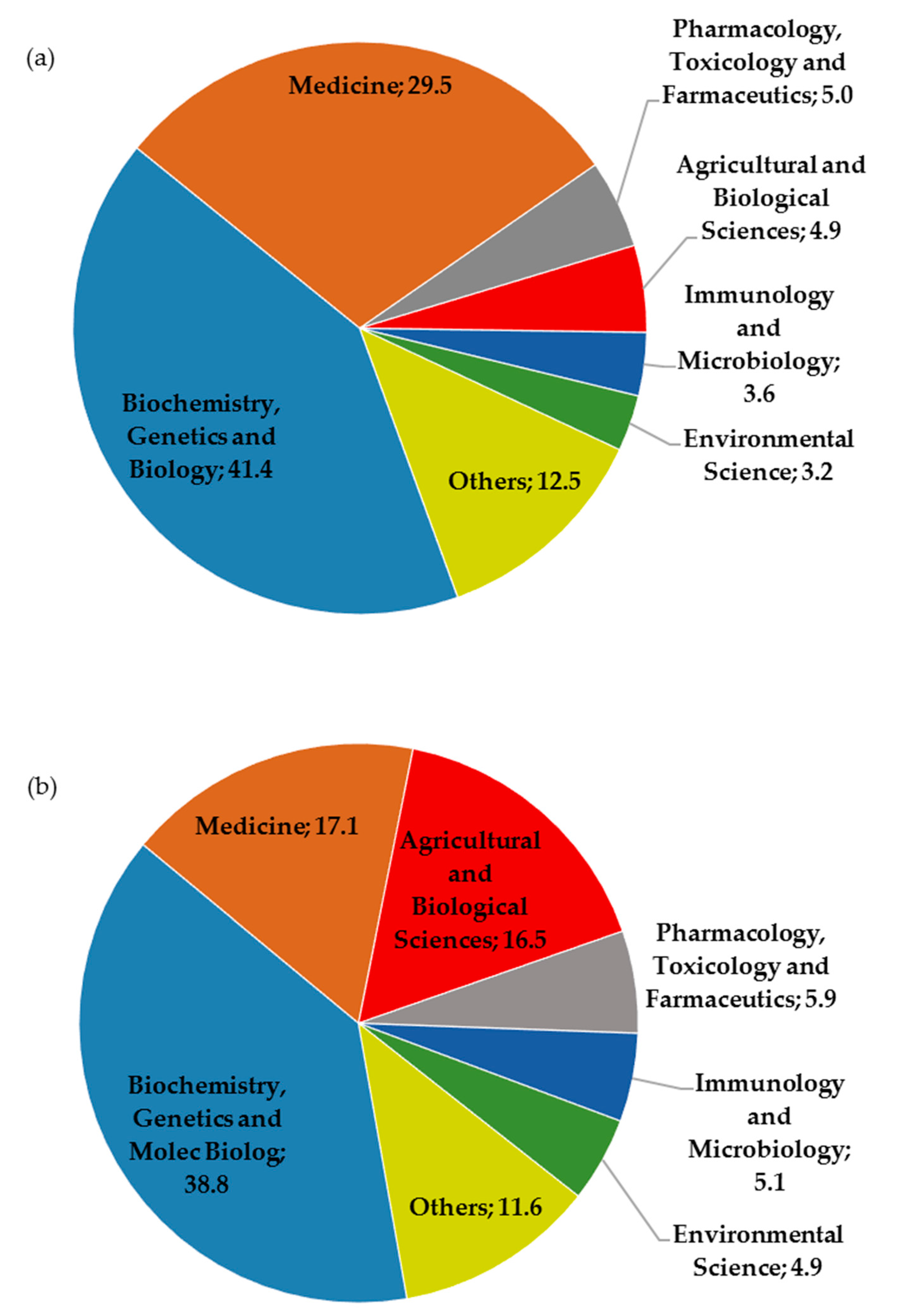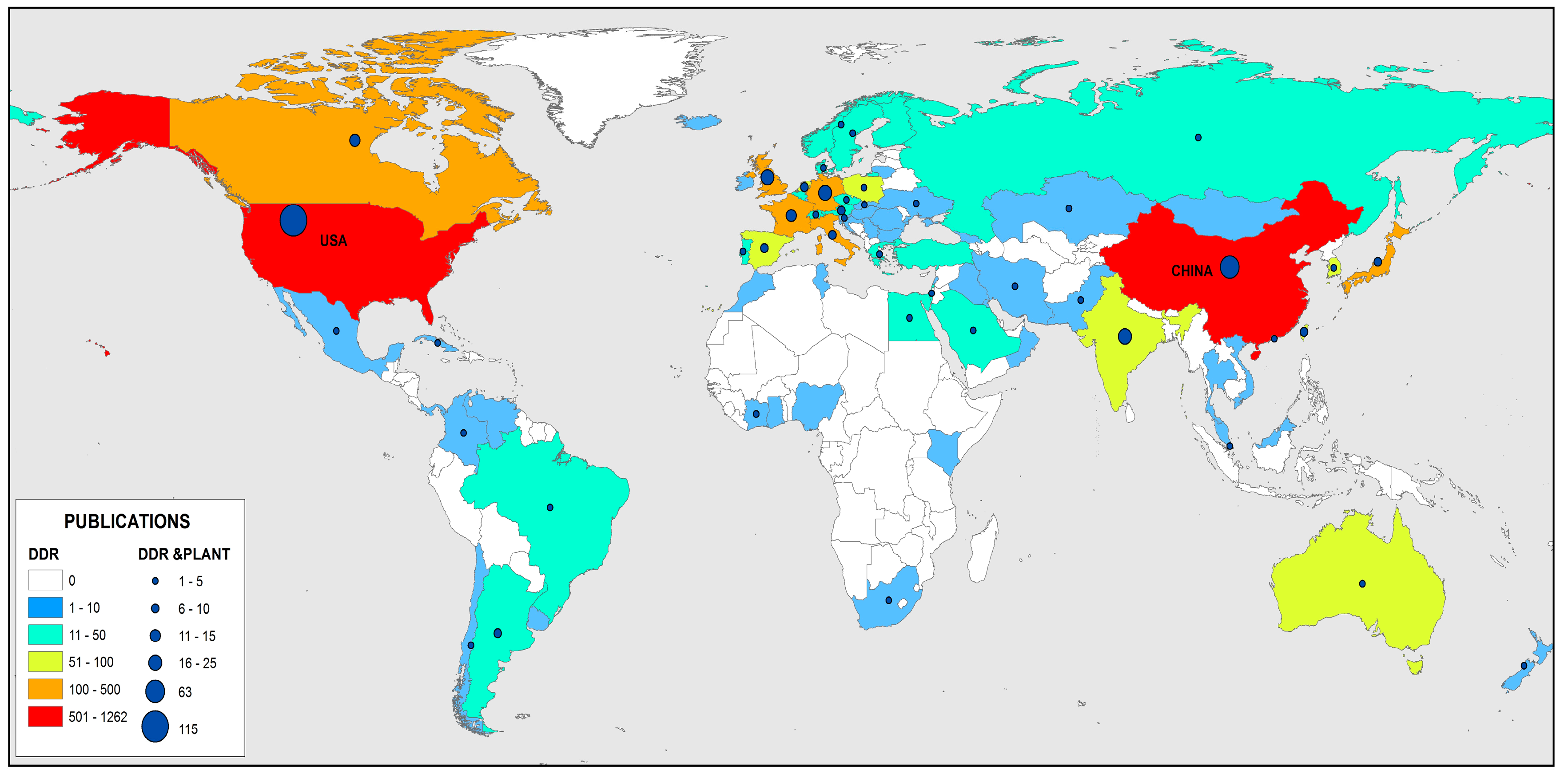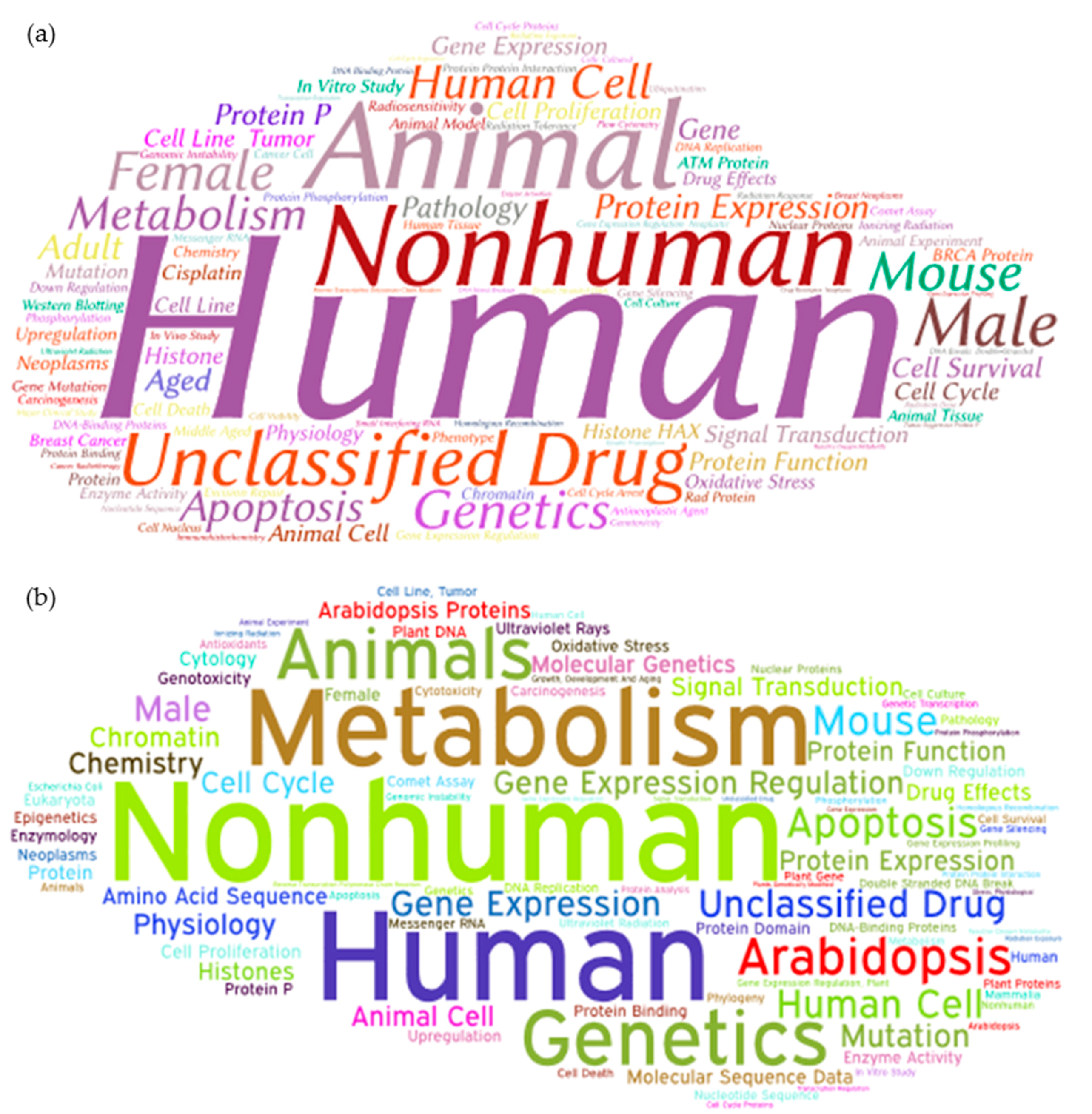DNA Damage Repair System in Plants: A Worldwide Research Update
Abstract
:1. Introduction
2. Materials and Methods
3. Results and Discussion
3.1. Evolution of Scientific Output
3.2. Types of Publications
3.3. Distribution of Output in Subject Categories and Journals
3.4. Publication Distribution by Countries and Institutions
3.5. Analysis of Keywords
4. Conclusions
Author Contributions
Conflicts of Interest
References
- Lindahl, T.; Barnes, D.E. Repair of endogenous DNA damage. Cold Spring Harbor Symp. Quant. Biol. 2000, 65, 127–133. [Google Scholar] [CrossRef] [PubMed]
- Hoeijmakers, J.H. DNA damage, aging, and cancer. N. Engl. J. Med. 2009, 361, 1475–1485. [Google Scholar] [CrossRef] [PubMed]
- Hosoya, N.; Miyagawa, K. Targeting DNA damage response in cancer therapy. Cancer Sci. 2014, 105, 370–388. [Google Scholar] [CrossRef] [PubMed]
- Ciccia, A.; Elledge, S.J. The DNA damage response: Making it safe to play with knives. Mol. Cell 2010, 40, 179–204. [Google Scholar] [CrossRef] [PubMed]
- Hoeijmakers, J.H. Genome maintenance mechanisms for preventing cancer. Nature 2001, 411, 366–374. [Google Scholar] [CrossRef] [PubMed]
- Shaltiel, I.A.; Krenning, L.; Bruinsma, W.; Medema, R.H. The same, only different—DNA damage checkpoints and their reversal throughout the cell cycle. J. Cell Sci. 2015, 128, 607–620. [Google Scholar] [CrossRef] [PubMed]
- Ryan, E.L.; Hollingworth, R.; Grand, R.J. Activation of the DNA Damage Response by RNA Viruses. Biomolecules 2016, 6, 2. [Google Scholar] [CrossRef] [PubMed]
- Hartwell, L.H.; Kastan, M.B. Cell cycle control and cancer. Science 1994, 266, 1821–1828. [Google Scholar] [CrossRef] [PubMed]
- Branzei, D.; Foiani, M. Regulation of DNA repair throughout the cell cycle. Nat. Rev. Mol. Cell Biol. 2008, 9, 297–308. [Google Scholar] [CrossRef] [PubMed]
- Reinhardt, H.C.; Yaffe, M.B. Kinases that control the cell cycle in response to DNA damage: Chk1, Chk2, and MK2. Curr. Opin. Cell Biol. 2009, 21, 245–255. [Google Scholar] [CrossRef] [PubMed]
- Bartek, J.; Lukas, J. DNA damage checkpoints: From initiation to recovery or adaptation. Curr. Opin. Cell Biol. 2007, 19, 238–245. [Google Scholar] [CrossRef] [PubMed]
- Halazonetis, T.D.; Gorgoulis, V.G.; Bartek, J. An oncogene-induced DNA damage model for cancer development. Science 2008, 319, 1352–1355. [Google Scholar] [CrossRef] [PubMed]
- Kroemer, G.; Mariño, G.; Levine, B. Autophagy and the integrated stress response. Mol. Cell 2010, 40, 280–293. [Google Scholar] [CrossRef] [PubMed]
- Lukas, J.; Lukas, C.; Bartek, J. Mammalian cell cycle checkpoints: Signalling pathways and their organization in space and time. DNA Repair 2004, 3, 997–1007. [Google Scholar] [CrossRef] [PubMed]
- Malumbres, M.; Barbacid, M. Cell cycle, CDKs and cancer: A changing paradigm. Nat. Rev. Cancer 2009, 9, 153–166. [Google Scholar] [CrossRef] [PubMed]
- Kastan, M.B.; Bartek, J. Cell-cycle checkpoints and cancer. Nature 2004, 432, 316–323. [Google Scholar] [CrossRef] [PubMed]
- Iyama, T.; Wilson, D.M. DNA repair mechanisms in dividing and non-dividing cells. DNA Repair 2013, 12, 620–636. [Google Scholar] [CrossRef] [PubMed]
- Bouwman, P.; Jonkers, J. The effects of deregulated DNA damage signalling on cancer chemotherapy response and resistance. Nat. Rev. Cancer 2012, 12, 587–598. [Google Scholar] [CrossRef] [PubMed]
- Ghosal, G.; Chen, J. DNA damage tolerance: A double-edged sword guarding the genome. Transl. Cancer Res. 2013, 2, 107–129. [Google Scholar] [CrossRef] [PubMed]
- Wolters, S.; Schumacher, B. Genome maintenance and transcription integrity in aging and disease. Front. Genet. 2013, 25, 19. [Google Scholar] [CrossRef] [PubMed]
- Jackson, S.P.; Bartek, J. The DNA-damage response in human biology and disease. Nature 2009, 461, 1071–1078. [Google Scholar] [CrossRef] [PubMed]
- Donà, M.; Scheid, O.M. DNA Damage Repair in the Context of Plant Chromatin. Plant Physiol. 2015, 168, 1206–1218. [Google Scholar] [CrossRef] [PubMed]
- Trapp, O.; Seeliger, K.; Puchta, H. Homologs of Breast Cancer Genes in Plants. Front. Plant Sci. 2011, 2, 19. [Google Scholar] [CrossRef] [PubMed]
- Britt, A. Repair of Damaged Bases. Arabidopsis Book 2002, 1, e0005. [Google Scholar] [CrossRef] [PubMed]
- Ries, G.; Buchholz, G.; Frohnmeyer, H.; Hohn, B. UV-damage-mediated induction of homologous recombination in Arabidopsis is dependent on photosynthetically active radiation. Proc. Natl. Acad. Sci. USA 2000, 97, 13425–13429. [Google Scholar] [CrossRef] [PubMed]
- Britt, A.B. DNA damage and repair in plants. Annu. Rev. Plant Physiol. Plant Mol. Biol. 1996, 47, 75–100. [Google Scholar] [CrossRef] [PubMed]
- Britt, A.B. Molecular genetics of DNA repair in higher plants. Trends Plant Sci. 1999, 4, 20–25. [Google Scholar] [CrossRef]
- Polyn, S.; Willems, A.; De Veylder, L. Cell cycle entry, maintenance, and exit during plant development. Curr. Opin. Plant Biol. 2015, 23, 1–7. [Google Scholar] [CrossRef] [PubMed]
- Bray, C.M.; West, C.E. DNA repair mechanisms in plants: Crucial sensors and effectors for the maintenance of genome integrity. New Phytol. 2005, 168, 511–528. [Google Scholar] [CrossRef] [PubMed]
- Yoshiyama, K.O.; Kobayashi, J.; Ogita, N.; Ueda, M.; Kimura, S.; Maki, H.; Umeda, M. ATM-mediated phosphorylation of SOG1 is essential for the DNA damage response in Arabidopsis. EMBO Rep. 2013, 14, 817–822. [Google Scholar] [CrossRef] [PubMed]
- Schuermann, D.; Molinier, J.; Fritsch, O.; Hohn, B. The dual nature of homologous recombination in plants. Trends Genet. 2005, 21, 172–181. [Google Scholar] [CrossRef] [PubMed]
- Cañas-Guerrero, I.; Mazarrón, F.R.; Pou-Merina, A.; Calleja-Perucho, C.; Díaz-Rubio, G. Bibliometric analysis of research activity in the “Agronomy” category from the Web of Science, 1997–2011. Eur. J. Agron. 2013, 50, 19–28. [Google Scholar] [CrossRef]
- Singh, V.; Perdigones, A.; Garcia, J.L.; Cañas-Guerroro, I.; Mazarrón, F.R. Analyzing worldwide research in hardware architecture, 1997–2011. Commun. ACM. 2015, 58, 76–85. [Google Scholar] [CrossRef]
- Rojas-Sola, J.I.; Aguilera-García, Á.I. Global Bibliometric Analysis of the ‘Mining & Mineral Processing’ Subject Category from the Web of Science (1997–2012). Miner. Process. Extr. Metall. Rev. 2015, 36, 349–369. [Google Scholar] [CrossRef]
- Montoya, F.G.; Baños, R.; Meroño, J.E.; Manzano-Agugliaro, F. The research of water use in Spain. J. Clean. Prod. 2016, 112, 4719–4732. [Google Scholar] [CrossRef]
- De la Cruz-Lovera, C.; Perea-Moreno, A.J.; de la Cruz-Fernández, J.L.; Alvarez-Bermejo, J.A.; Manzano-Agugliaro, F. Worldwide Research on Energy Efficiency and Sustainability in Public Buildings. Sustainability 2017, 9, 1294. [Google Scholar] [CrossRef]
- Salmerón-Manzano, E.; Manzano-Agugliaro, F. Worldwide scientific production indexed by Scopus on Labour Relations. Publications 2017, 5, 25. [Google Scholar] [CrossRef]
- Mongeon, P.; Paul-Hus, A. The journal coverage of Web of Science and Scopus: A comparative analysis. Scientometrics 2016, 106, 213–228. [Google Scholar] [CrossRef]
- Archambault, É.; Campbell, D.; Gingras, Y.; Larivière, V. Comparing bibliometric statistics obtained from the Web of Science and Scopus. J. Am. Soc. Inf. Sci. Technol. 2009, 60, 1320–1326. [Google Scholar] [CrossRef]
- Montoya, F.G.; Montoya, M.G.; Gómez, J.; Manzano-Agugliaro, F.; Alameda-Hernández, E. The research on energy in Spain: A scientometric approach. Renew. Sustain. Energy Rev. 2014, 29, 173–183. [Google Scholar] [CrossRef]
- Montoya, F.G.; Alcayde, A.; Baños, R.; Manzano-Agugliaro, F. A fast method for identifying worldwide scientific collaborations using the Scopus database. Telemat. Inform. 2017, in press. [Google Scholar] [CrossRef]
- Hirsch, J.E.; Buela-Casal, G. The meaning of the h-index. Int. J. Clin. Hlth. Psyc. 2014, 14, 161–164. [Google Scholar] [CrossRef]
- Alonso, S.; Cabrerizo, F.J.; Herrera-Viedma, E.; Herrera, F. H-Index: A review focused in its variants, computation and standardization for different scientific fields. J. Informetr. 2009, 3, 273–289. [Google Scholar] [CrossRef]
- Bornmann, L.; Mutz, R.; Hug, S.E.; Daniel, H.D. A multilevel meta-analysis of studies reporting correlations between the h index and 37 different h index variants. J. Informetr. 2011, 5, 346–359. [Google Scholar] [CrossRef]
- Garrido-Cardenas, J.A.; Manzano-Agugliaro, F. The metagenomics worldwide research. Curr. Genet. 2017, 63, 819–829. [Google Scholar] [CrossRef] [PubMed]
- Choi, J.; Yi, S.; Lee, K.C. Analysis of keyword networks in MIS research and implications for predicting knowledge evolution. Inf. Manag. 2011, 48, 371–381. [Google Scholar] [CrossRef]
- Doonan, J.; Hunt, T. Cell cycle. Why don't plants get cancer? Nature 1996, 380, 481–482. [Google Scholar] [CrossRef] [PubMed]
- Doonan, J.H.; Sablowski, R. Walls around tumours—Why plants do not develop cancer. Nat. Rev. Cancer 2010, 10, 794–802. [Google Scholar] [CrossRef] [PubMed]
- Nikitaki, Z.; Pavlopoulou, A.; Holá, M.; Donà, M.; Michalopoulos, I.; Balestrazzi, A.; Angelis, K.J.; Georgakilas, A.G. Bridging Plant and Human Radiation Response and DNA Repair through an In Silico Approach. Cancers 2017, 9, 65. [Google Scholar] [CrossRef] [PubMed]
- Ma, H.; Song, T.; Wang, T.; Wang, S. Influence of Human p53 on Plant Development. PLoS ONE 2016, 11, e0162840. [Google Scholar] [CrossRef] [PubMed]
- Gao, L.; Yang, S.; Zhu, Y.; Zhang, J.; Zhuo, M.; Miao, M.; Tang, X.; Liu, Y.; Wang, S. The tomato DDI2, a PCNA ortholog, associating with DDB1-CUL4 complex is required for UV-damaged DNA repair and plant tolerance to UV stress. Plant Sci. 2015, 235, 101–110. [Google Scholar] [CrossRef] [PubMed]
- Tam, S.M.; Hays, J.B.; Chetelat, R.T. Effects of suppressing the DNA mismatch repair system on homeologous recombination in tomato. Theor. Appl. Genet. 2011, 123, 1445–1458. [Google Scholar] [CrossRef] [PubMed]
- Kou, Y.; Chang, Y.; Li, X.; Xiao, J.; Wang, S. The rice RAD51C gene is required for the meiosis of both female and male gametocytes and the DNA repair of somatic cells. J. Exp. Bot. 2012, 63, 5323–5335. [Google Scholar] [CrossRef] [PubMed]
- Gruszka, D.; Marzec, M.; Szarejko, I. The barley EST DNA Replication and Repair Database (bEST-DRRD) as a tool for the identification of the genes involved in DNA replication and repair. BMC Plant Biol. 2012, 12, 88. [Google Scholar] [CrossRef] [PubMed]
- Manova, V.; Gruszka, D. DNA damage and repair in plants—From models to crops. Front. Plant Sci. 2015, 6, 885. [Google Scholar] [CrossRef] [PubMed]
- Biankin, A.V.; Waddell, N.; Kassahn, K.S.; Gibbs, R.A.; Grimmond, S.M. Pancreatic cancer genomes reveal aberrations in axon guidance pathway genes. Nature 2012, 491, 399–405. [Google Scholar] [CrossRef] [PubMed] [Green Version]
- Braithwaite, E.K.; Kedar, P.S.; Lan, L.; Yasui, A.; Wilson, S.H. DNA polymerase λ protects mouse fibroblasts against oxidative DNA damage and is recruited to sites of DNA damage/repair. J. Biol. Chem. 2005, 280, 31641–31647. [Google Scholar] [CrossRef] [PubMed]
- Waddell, N.; Pajic, M.; Patch, A.-M.; Biankin, A.V.; Grimmond, S.M. Whole genomes redefine the mutational landscape of pancreatic cancer. Nature 2015, 518, 495–501. [Google Scholar] [CrossRef] [PubMed]
- Morrison, A.J.; Highland, J.; Krogan, N.J.; Haber, J.E.; Shen, X. INO80 and γ-H2AX interaction links ATP-dependent chromatin remodeling to DNA damage repair. Cell 2004, 119, 767–775. [Google Scholar] [CrossRef] [PubMed]
- Asaithamby, A.; Hu, B.; Chen, D.J. Unrepaired clustered DNA lesions induce chromosome breakage in human cells. Proc. Natl. Acad. Sci. USA 2011, 108, 8293–8298. [Google Scholar] [CrossRef] [PubMed]
- Zhang, M.; Kleber, S.; Röhrich, M.; Lahn, M.; Huber, P.E. Blockade of TGF-β signaling by the TGFβR-I kinase inhibitor LY2109761 enhances radiation response and prolongs survival in glioblastoma. Cancer Res. 2011, 71, 7155–7167. [Google Scholar] [CrossRef] [PubMed]
- Tuteja, N.; Ahmad, P.; Panda, B.B.; Tuteja, R. Genotoxic stress in plants: Shedding light on DNA damage, repair and DNA repair helicases. Mutat. Res. Rev. Mutat. Res. 2009, 681, 134–149. [Google Scholar] [CrossRef] [PubMed]
- FAO (Food and Agriculture Organization of the United Nations). The State of Food Security and Nutrition in the World 2017. Available online: www.fao.org/3/a-I7695e.pdf (accessed on 30 September 2017).






| Document Type | DDR (Records) | DDR (%) | DDR & Plant (Records) | DDR & Plant (%) |
|---|---|---|---|---|
| Article | 2278 | 77.99 | 217 | 76.41 |
| Review | 469 | 16.06 | 48 | 16.90 |
| Conference Paper | 59 | 2.02 | 4 | 1.41 |
| Book Chapter | 55 | 1.88 | 8 | 2.82 |
| Short Survey | 26 | 0.89 | 5 | 1.76 |
| Note | 13 | 0.45 | ~ | ~ |
| Erratum | 7 | 0.24 | 1 | 0.35 |
| Article in Press | 6 | 0.21 | 1 | 0.35 |
| Book | 4 | 0.14 | ~ | ~ |
| Editorial | 2 | 0.07 | ~ | ~ |
| Letter | 2 | 0.07 | ~ | ~ |
| Total | 2921 | 284 |
| DDR | DDR & Plant | |||||
|---|---|---|---|---|---|---|
| Position | Source Name | Records | h-Index | Source Name | Records | h-Index |
| 1 | PLoS ONE | 82 | 20 | Plant Physiology | 9 | 7 |
| 2 | Cancer Research | 64 | 34 | Plant Cell | 7 | 7 |
| 3 | Journal of Biological Chemistry | 49 | 25 | PNAS | 6 | 6 |
| 4 | Oncogene | 48 | 28 | Frontiers in Plant Science | 5 | 5 |
| 5 | DNA Repair | 43 | 20 | Plant Journal | 5 | 4 |
| 6 | Cell Cycle | 41 | 16 | DNA Repair | 4 | 3 |
| 7 | Oncotarget | 40 | 12 | International Journal of Molecular Sciences | 4 | 4 |
| 8 | Nucleic Acids Research | 35 | 17 | Mutation Research Reviews in Mutation Research | 4 | 4 |
| 9 | Clinical Cancer Research | 33 | 19 | Nucleic Acids Research | 4 | 4 |
| 10 | PNAS | 33 | 27 | Oncogene | 4 | 4 |
| PLoS ONE | 4 | 3 | ||||
| DDR | DDR & Plant | |||||
|---|---|---|---|---|---|---|
| Affiliation | Country | Records | Affiliation | Country | Records | |
| 1 | National Institutes of Health, Bethesda, | USA * | 82 | Chinese Academy of Sciences, | China | 13 |
| 2 | University of Texas M. D. Anderson Cancer Center, | USA * | 82 | Ministry of Education, | China | 9 |
| 3 | National Cancer Institute, Bethesda, | USA * | 64 | Inserm, Institut national de la santé et de la recherche médicale, | France * | 6 |
| 4 | Harvard Medical School, | USA * | 51 | Centre National de la Recherche Scientifique (CNRS), | France | 6 |
| 5 | Chinese Academy of Sciences, | China | 46 | Howard Hughes Medical Institute, | USA * | 6 |
| 6 | Ministry of Education China, | China | 39 | UC Davis, | USA | 5 |
| 7 | Howard Hughes Medical Institute | USA * | 34 | Cincinnati Children’s Hospital Medical Center, | USA * | 4 |
| 8 | Inserm, Institut national de la santé et de la recherche médicale, | France * | 31 | University of Missouri-Columbia, | USA | 4 |
| 9 | University of Toronto, | Canada | 31 | Consejo Superior de Investigaciones Científicas, | Spain | 4 |
| 10 | University of Michigan Medical School, | USA * | 31 | Bose Institute, | India | 4 |
| 11 | Dana-Farber Cancer Institute, Boston, | USA * | 30 | University of Colorado Health Sciences Center, | USA * | 4 |
| 12 | UT Southwestern Medical Center, Dallas, | USA * | 29 | Sichuan University, | China | 4 |
| 13 | Erasmus University Medical Center, Roterdam, | The Netherlands * | 29 | Academia Sinica, | Taiwan | 4 |
| 14 | CNRS Centre National de la Recherche Scientifique, | France | 28 | University of Texas Health Science Center at San Antonio, | USA * | 4 |
| 15 | Memorial Sloan-Kettering Cancer Center, Philadelphia, | USA * | 28 | Alfred-Wegener-Institut Helmholtz-Zentrum für Polar- und Meeresforschung, | Germany | 4 |
| 16 | Fudan University, Shanghai, | China | 28 | UC Berkeley, | USA | 4 |
| 17 | Cancer Research, | UK* | 28 | Universidad Nacional de Rosario, | Argentina | 4 |
| 18 | University of Oxford, | UK | 28 | Centro de Estudios Fotosintéticos Y Bioquímicos, Rosario, | Argentina # | 4 |
| 19 | VA Medical Center, | USA * | 27 | University of California Los Angeles, | USA | 4 |
| 20 | University of California San Francisco, | USA | 27 | Max Planck Institute für Züchtungsforschung, Cologne, | Germany # | 4 |
| DDR | DDR & Plant | |||
|---|---|---|---|---|
| Language | Reports | % | Reports | % |
| English | 2776 | 94.84 | 273 | 96.13 |
| Chinese | 106 | 3.62 | 8 | 2.82 |
| Russian | 12 | 0.41 | 3 | 1.06 |
| Polish | 9 | 0.31 | ||
| Japanese | 8 | 0.27 | ||
| French | 4 | 0.14 | ||
| German | 2 | 0.07 | ||
| Spanish | 2 | 0.07 | ||
| Turkish | 2 | 0.07 | ||
| Bulgarian | 1 | 0.03 | ||
| Dutch | 1 | 0.03 | ||
| Italian | 1 | 0.03 | ||
| Portuguese | 1 | 0.03 | ||
| Serbian | 1 | 0.03 | ||
| Ukrainian | 1 | 0.03 | ||
© 2017 by the authors. Licensee MDPI, Basel, Switzerland. This article is an open access article distributed under the terms and conditions of the Creative Commons Attribution (CC BY) license (http://creativecommons.org/licenses/by/4.0/).
Share and Cite
Gimenez, E.; Manzano-Agugliaro, F. DNA Damage Repair System in Plants: A Worldwide Research Update. Genes 2017, 8, 299. https://doi.org/10.3390/genes8110299
Gimenez E, Manzano-Agugliaro F. DNA Damage Repair System in Plants: A Worldwide Research Update. Genes. 2017; 8(11):299. https://doi.org/10.3390/genes8110299
Chicago/Turabian StyleGimenez, Estela, and Francisco Manzano-Agugliaro. 2017. "DNA Damage Repair System in Plants: A Worldwide Research Update" Genes 8, no. 11: 299. https://doi.org/10.3390/genes8110299






